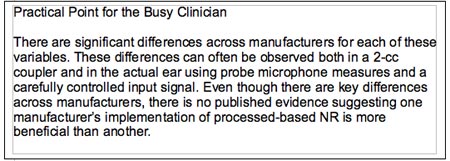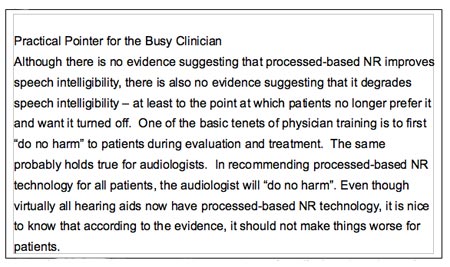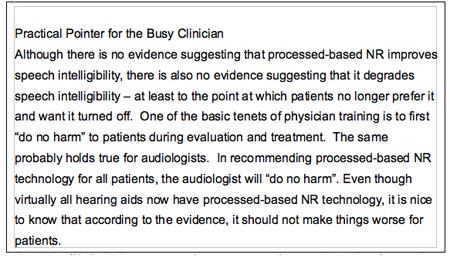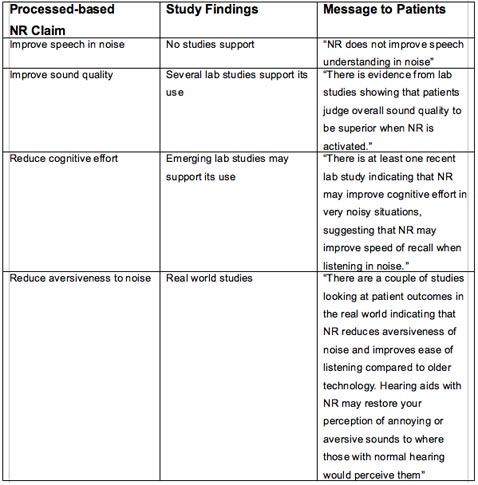The purpose of this review article is to familiarize clinicians with some of the current trends related to processed-based noise reduction (NR) schemes used in modern hearing aids, and how the latest research findings can be used in the hearing aid selection and counseling process. Much of the literature devoted to digital hearing aids, specifically processed based NR algorithms, is authored by engineers and Ph.D. audiologists that do not see patients in a commercial practice or clinic. Although these contributions are essential to the profession, they are not always geared to the more practically-minded audiologist who is trying to run a busy practice, and may not have the time to carefully analyze the subtle differences in noise reduction schemes across various product lines. A primary focus of this short tutorial is to bridge the gap between these important technical details (some of the seminal references are included), and the recommendation of hearing aids with various types of NR schemes by dispensing professionals. Additionally, the goal is to provide the workaday clinician with some key talking points, supported by the clinical evidence, which can be shared with patients during the hearing aid selection process.
Processed-based NR can be defined as any type of scheme in which a mathematical calculation is employed by the hearing aid's signal classification system to separate a desired signal (usually speech) from an undesirable signal (usually background noise). Processed-based NR algorithms are one of two types of NR strategies employed by modern hearing aids with the other being spatially-based NR schemes. Spatially-based NR schemes refer to the use of directional microphone technology to manage background noise. While directional microphone technology is usually combined with processed-based NR in many modern hearing aids, because it operates under the premise of spatially separating the signal of interest from unwanted sounds, it will not be included in this review.
A brief history of processed-based noise reduction
Processed-based NR (sometimes known as digital NR) is certainly not a new technological development ushered in with the advent of digital hearing aids. In fact, analog NR has a relatively long and storied history as a method for reducing background noise going back several decades.
In the 1980's, single-channel analog hearing aids were sometimes equipped with active low-cut tone controls as a way to manually reduce low frequency types of ambient sound. Later in the decade, Automatic Signal Processing (ASP) was introduced as a method for automatically reducing low frequency sounds. Many remember the days when BILL (bass increase at low levels) and TILL (treble increase at low levels) processing were used to combat noise with ASP being a specific type of BILL processing. In addition to manual switches and BILL/TILL schemes, two proprietary signal processing schemes, Adaptive Compression and the Zeta Noise Blocker, were introduced to the market around this time with mixed results.
Although many of these analog NR schemes were popular throughout the '80s to mid '90s, research indicated that they were ineffective at improving speech intelligibility in noise and contributed to poor sound quality (Bentler, Niebuhr, Getta, & Anderson, 1993a, 1993b). With the introduction of digital signal processing in commercially available hearing aids in the mid-1990s, a processed-based solution to reducing background noise was once again a possibility. Since the introduction of digital hearing aids in the mid-1990's processed-based noise reduction strategies have grown more complex.
What's inside the black box?
Often times the interworking of NR algorithms are shrouded in mystery. It isn't easy for clinicians when it comes to understanding how various types of NR algorithms actually work, because hearing aid manufacturers often use proprietary terms and jargon to describe how their products are different from the competition. Even though there are important differences across product lines, there are some commonalities that can help to demystify the black box.
Today, most hearing aids have more than one type of NR scheme. Many schemes are modulation-based and rely on the signal classification system of the hearing aid to count the number and depth of modulations of the input signal. Modulation-based NR systems work under the premise that speech stimuli have fewer modulations (Hz) with more depth (dB) than most noise stimuli. Typically, modulation frequency and depth are analyzed independently in each channel of the instrument. If the input signal is classified as noise the intensity of the signal is reduced, and if it is classified as speech, the intensity level may be increased for each channel.
In addition to modulation-based NR strategies, most hearing aids employ some combination of spectral subtraction, co-modulation detection, impulse-noise reduction, expansion or wind noise reduction to suppress noise. Each type of processed-based noise reduction strategy has its own operating principles and complexities that go well beyond the scope of this tutorial. The interested professional is encouraged to read James M. Kates' (2008) excellent textbook, Digital Hearing Aids for more details on the intricacies of current and a few future NR algorithms.
Regardless of the type of processed-based NR strategy used in modern hearing aids, there are a few characteristics that vary between manufacturers and product lines. Chung (2004) and Bentler & Chiou (2006) published useful reviews of these variables, and the reader should consult those articles for more detailed information. The following acoustic parameters, summarized below, vary between manufacturers.
- Gain Reduction. Once the hearing aid's signal classification system has determined that the input signal is noise, how much does it reduce the noise signal? All product lines reduce gain in varying amounts across the frequency range.
- Gain Enhancement. Once a signal has been classified as speech, does the hearing aid boost the gain of the speech signal? The amount of gain enhancements varies across frequency as well.
- Activation Time (Onset and Offset Time). Once the input signal has been classified as noise, how long does it take to reduce the noise signal? In addition to activation time, another consideration is speed of the gain recovery. In other words, when the input signal classified as noise is no longer present, how long does it take for the gain to increase?
- Signal-to-Noise Ratio Required to Activate the Noise Reduction Scheme. At what signal-to-noise ratio is the noise reduction scheme activated, and how much is gain reduced at various signal-to-noise ratios?

Processed-based noise reduction claims
A primary goal of hearing aid fitting is to restore audibility of speech. In most cases, simply restoring audibility for quiet sounds does not solve all of the communication problems associated with hearing loss. Audiologists have to rely on advanced features, like NR algorithms to alleviate many of these existing communication problems. According to popular opinion, processed-based NR schemes have the potential to improve several important dimensions of communication, including the following:
- Improve speech intelligibility in noise. The NR algorithm is able to improve the signal-to-noise ratio of the listening situation resulting in an improvement in speech intelligibility. Although directional microphone technology has been proven in laboratory conditions to improve speech intelligibility in noise, marketing claims have sometimes touted the potential of NR algorithms to improve speech understanding ability.
- Make loud sounds more tolerable. The NR algorithm is able to recognize impulse-like sounds that may exceed the loudness discomfort level of the patient and reduce them. While the primary function of AGC-O is to keep the hearing aids' maximum power output (MPO) below the discomfort level of the patient, NR schemes have the potential to protect the patient from sudden, high-intensity transient sounds.
- Improve listening comfort in noise / Reduce annoyance from noise. Overall listening comfort, sometimes referred to as "more relaxed listening" is improved with the use of processed-based NR. Traditionally, patients have had to reduce the gain on their hearing aids or remove them from their ears when bothered by background noise. Processed-based NR has the potential to reduce annoyance/aversiveness or improve listening comfort without compromising audibility.
- Improve cognitive resource allocation / Reduce cognitive effort. Perhaps an overlooked by-product of processed-based NR is that it has the potential to lighten the cognitive workload. In other words, when NR is activated, the brain may be able to allocate attention-related resources to other tasks occurring simultaneously. For example let's say you are trying to learn an important new skill by watching a DVD, while simultaneously ignoring the din of your husband using a Cuisinart for several minutes. In theory, processed-based NR has the potential to reduce cognitive workload by reducing the sounds of the food processor so that you can focus your attention on another task (i.e. watching the DVD) for a longer period of time.
Processed-based noise reduction effectiveness
Processed-based NR strategies have the potential to address the challenges associated with hearing loss listed above. The effectiveness of process-based NR schemes can be evaluated by systematically conducting an evidence-based review.
The first step to conducting an evidence-based review is asking a focused question, followed by a review of the pertinent research, grading of the evidence and rendering a judgment based on the reading of the evidence. Based on knowledge of how processed-based NR works, four clinically relevant questions can be posed. Summary findings of an evidence-based review are listed for the four questions.
Question #1: Does processed-based noise reduction improve speech intelligibility?
The research has consistently demonstrated that processed-based NR schemes do not improve speech intelligibility in noise. Bentler (2005) conducted an evidence-based review of NR effectiveness. Of the two studies meeting her review criteria neither study indicated that speech intelligibility in noise was improved with noise reduction technology. More recent studies published by Ricketts & Hornsby (2005), Bentler, Wu, Kettel & Hurtig (2008) and Sarampolis, Kalluri, Edwards & Hafter (2009) also did not show any objective speech intelligibility in noise improvements when the NR algorithm was activated. Based on these findings there is no evidence supporting the use of processed-based NR for improving speech intelligibility in noise.
Question #2: Do listeners report improved sound quality in noise when using hearing aids with processed-based noise reduction?
Several laboratory studies have shown that processed-based NR provides improved sound quality for speech in noisy listening conditions. Alcantara, Moore, Kuhnel & Launer (2003) evaluated eight experienced hearing aid wearers who wore new hearing aids for three months. They found no reduction in sound quality while listening to four different types of noise in a laboratory condition.
Ricketts & Hornsby (2005) conducted sound quality measures for speech in noise on 14 subjects using hearing aids with NR algorithms at two different signal-to-noise ratios. Paired comparisons in which the subject had to made a forced choice between two conditions (NR-on and NR-off) showed a strong preference for the NR-on condition. Other studies (Walden, Surr, Cord, Edwards, & Olson, 2000; Boymans & Dreschler, 2000) also indicate a preference for process-based NR turned on. Based on several laboratory studies, sound quality in noise is improved with NR algorithms.
Question #3: Do listeners report less aversiveness or annoyance to sound when using hearing aids with processed-based noise reduction?
As mentioned previously, a potential benefit of NR is to make background noise less annoying or noisy listening conditions less aversive. Several studies, using either laboratory or real-world measures, have been conducted over the past few years examining how NR algorithms affect annoyance and aversiveness. Mueller, Weber & Hornsby (2006) evaluated the aided annoyance levels of 22 participants using the Acceptable Noise Level (ANL) test. Results indicated that the mean aided ANL score improved approximately 4 dB, indicating that NR algorithms have the ability to reduce annoyance from noise in laboratory conditions.
In order to evaluate the real-world effectiveness of NR for reducing annoyance from background noise, the aversiveness subscale on the Abbreviated Profile of Hearing Aid Benefit (APHAB) has been used. Bentler et al. (2008) evaluated 25 participants using a combination of laboratory and self-report measures. Results of the aversiveness APHAB subscale show that participants reported more aversiveness in the NR-off condition than the unaided pre-test condition. The APHAB was also administered in three aided conditions in which the onset time of the NR varied. Results in the NR conditions show a small, but significant improvement on the aversiveness subscale relative to the NR-off condition. These results are similar to those reported previously by Palmer, Bentler & Mueller (2006), who evaluated self-reports of annoyance and aversiveness ratings of 49 listeners. Their results indicated that annoyance and aversiveness ratings increase with amplification. Importantly, however, amplification returns a normal perception of annoyance and aversiveness.
More recently, Johnson et al. (in press) evaluated self-reports of outcome using the APHAB on 154 hearing aid users of wide dynamic range compression and other more advanced features. APHAB results of the 154 users were compared to APHAB data collected in the mid-1990s from a similar group of linear hearing aid users. Three of the four subscales on the APHAB from the 154 listeners of hearing aids with advanced features showed no significant differences compared to the previous group of linear amplification users. On the APHAB aversiveness subscale, however, the current group of users showed significant improvement (less aversiveness) compared to the linear users. These results suggest that processed-based NR strategies reduce annoyance.
The finding on self-reports of outcome that annoyance and aversiveness ratings increase with amplification to levels similar to normal hearing listeners has important counseling expectations. Hearing aid use restores audibility of sounds and a known by-product is to increase annoyance and aversiveness, but not more than those listeners with normal hearing. On the other hand, hearing aids with NR strategies appear to improve aversiveness in noisy conditions compared to linear hearing aids without advanced NR strategies.
Question #4: Do patients report a reduction in cognitive effort when using hearing aids with processed-based noise reduction?
Some researchers have speculated that processed-based NR might have the potential to improve central auditory space allocation, which could assist in cognitive processing and learning. Marcoux, Yathiraj, Cote, & Logan (2006) studied the effects that the NR has on novel word learning. This was accomplished by training adults to discriminate between non-native speech contrasts in noise, and comparing scores for the NR-activated condition to the NR-inactivated condition. Results indicated NR-activated has no effect on novel word learning; thus, NR does not appear to enhance nor impair the acquisition of novel speech contrasts by adult listeners.
Results of two recently published laboratory experiments by Sarampalis, et al. (2009) indicate that the presence of background noise during a listening task can have negative effects on cognitive activities, such as remembering words or responding quickly in a complex visual task. One experiment found that average reaction time improved by about one-tenth of a second at unfavorable signal-to-noise listening levels (-6 dB) when NR processing is activated. Another determined that percentage of words recalled at aversive signal-to-noise ratios (-2 dB) improved by approximately 10% when NR was activated. The findings from Sarampalis et al. (2009) suggest that NR processing may allow listeners to focus more of their attention on a specific task, rather than the background noise. Taken collectively, studies examining the effects of NR on cognitive processing suggest that NR algorithms have no negative consequences on learning, and might have the ability to reduce listening effort when subjects are performing novel cognitive tasks in noise.
A Pragmatic Approach to Working with Process-based NR
One of the challenges in clinical practice is incorporating research findings into a meaningful clinician-patient dialogue. Table 1 is designed to help clinicians summarize NR research findings and use the information when counseling patients. The first column lists four popular NR claims and the second column summarizes the research trends associated with each claim. The third column offers suggestions on how to convey these findings to patients during the pre-fitting appointment. When professionals can effectively communicate NR performance expectations, it instills confidence in the professional by the patient, and helps reassure the patient about product offerings.
Table 1. A summary of key patient messages for four common noise reduction claims.
A Checklist for Fitting Hearing Aids with Processed-based NR
- Verify. Before the patient arrives in the clinic for the hearing aid fitting, confirm that NR is working by conducting 2-cc coupler measures using a noise-like input signal. Many hearing aid analyzers have special programs that vary the input signal in such a way that the aggressiveness of the NR algorithms can be evaluated with various types of input signals. Although there are no independent reports indicating that one manufacturer's NR is more advantageous than another, conducting a 2-cc coupler measure with the proper input signal verifies that the NR algorithms within the hearing aid are working.
- Demonstrate. During the fitting, demonstrate to the patient that NR is working by conducting probe microphone measures. These can be conducted in several ways. For example, live speech can be used as the input signal and various types of background noise can be introduced, while the patient views the video monitor to see how noise is managed by the NR system. Another approach would be to use two or more different types of noise inputs that vary in intensity or modulation frequency to demonstrate how the NR system handles different types of noise inputs.
- Counsel. During the orientation phase of the fitting appointment, counsel patients that hearing aids will restore annoyance to background noise to normal perception levels, but today's hearing aids are more effective at reducing aversion to noise than older models that did not use processed-based NR. Therefore, even if annoyance levels are restored to normal levels, hearing aids with NR algorithms can be expected to help patients lessen their aversion to certain types of sounds in everyday listening.
- Measure Outcomes. There are many reports that closed-set self-reports such as the APHAB are not sensitive enough to capture many of the subtle real-world listening benefits of processed-based NR. Therefore, open-set measures of outcome, such as the COSI or a personal journal can be used to evaluate real-world outcomes of hearing aids.
Summary
As processed-based NR programs have grown in complexity, they have become increasingly difficult for audiologists to fully understand. Rather than ponder the intricacies of the various NR strategies inside their proverbial black boxes, audiologists can confidently recommend process-based NR strategies. The preponderance of research indicates that process-based NR schemes, in general, do no harm to the patient and have the potential to improve listening comfort and cognitive resource allocation. Therefore, audiologists can tout these potential advantages while clearly communicating the limitation of processed-based NR strategies, which is that they do not improve speech intelligibility. Processed-based NR in all its implementations across various product lines is one of several advanced hearing aid features audiologists can rely on to manage background noise, increase utilization of hearing aids and ultimately improve overall patient satisfaction.
References
Alcantara, J., Moore, B., Kuhnel, V. & Launer, S. (2003). Evaluation of the noise reduction system is a commercial digital hearing aid. International Journal of Audiology, 42(1), 34-42.
Bentler, R. (2005). Effectiveness of directional microphones and noise reduction schemes in hearing aids: A systematic review of the evidence. Journal of the American Academy of Audiology,16(7), 473-484.
Bentler, R. & Chiou, L. (2006). Digital noise reduction: An overview. Trends in Amplification,10(2), 67-81.
Bentler, R., Wu, Y-H., Kettel, J., & Hurtig, R. (2008). Digital noise reduction: outcomes from laboratory and field studies. International Journal of Audiology, 47(8), 447-460.
Bentler, R.A., Niebuhr, D.P., Getta, J.P., & Anderson, C.V. (1993a). Longitudinal study of hearing aid effectiveness I: Objective measures. Journal of Speech and Hearing Research, 36(4), 808-819.
Bentler, R.A., Niebuhr, D.P., Getta, J.P., & Anderson, C.V. (1993b). Longitudinal study of hearing aid effectiveness II: Subjective measures. Journal of Speech and Hearing Research, 36(4), 820-831.
Boymans, M. & Dreschler, W.A. (2000) Field trials using a digital hearing aid with active noise reduction and dual-microphone directionality. Audiology, 39(5), 260-268.
Chung, K. (2004). Challenges and recent developments in hearing aids. Part 1: Understanding in noise, microphone technologies and noise reduction algorithms. Trends in Amplification,8(3), 83-124.
Johnson, J. et al. (in press). Development of APHAB norms for WDRC hearing aids and comparison with original norms. Ear and Hearing.
Kates, J.M. (2008). Digital hearing aids. San Diego: Plural Publishing.
Marcoux, A., Yathiraj, A., Cote, I., Logan, J. (2006). The effect of a hearing aid noise reduction algorithm on the acquisition of novel speech contrasts. International Journal of Audiology, 45(12), 707-714.
Mueller, H.G., Weber, J., & Hornsby, B.W.Y. (2006). The effects of digital noise reduction on the acceptance of background noise. Trends in Amplification,10(2), 83-94.
Palmer, C., Bentler, R., & Mueller, H.G. (2006). Amplification with digital noise reduction and the perception of annoying and aversive sounds. Trends in Amplification, 10(2), 95-104.
Ricketts, T & Hornsby, B. (2005) Sound quality measures for speech in noise through a commercial hearing aid implementing digital noise reduction. Journal of the American Academy of Audiology, 16(5), 270-277.
Sarampalis, A., Kalluri, S., Edwards, B., & Hafter, E. (2009). Objective measures of listening effort: effects of background noise and noise reduction. Journal of Speech, Language and Hearing Research, 52(10), 1230-1240.
Walden, B.E., Surr, R.K., Cord, M.T., Edwards, B., Olson, L. (2000). Comparison of benefits provided by different hearing-aid technologies. Journal of the American Academy of Audiology,11, 540-560.


